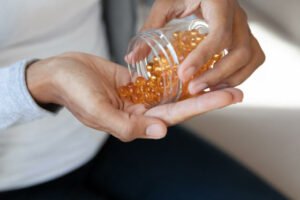Menopause is a natural and inevitable phase in a woman’s life, marking the end of her reproductive years. However, the hormonal changes that accompany menopause can lead to various symptoms, including Genitourinary Syndrome of Menopause (GSM). GSM encompasses a range of symptoms affecting the genital and urinary tract due to hormonal fluctuations. In recent years, there has been increasing interest in GSM menopause treatment options to alleviate these symptoms and improve women’s quality of life. In this blog, we have discussed all the GSM Treatment options and how to get this treatment.
Contents
- 1 What Does GSM Mean?
- 2 Treatment Options for GSM
- 2.1 1. Hormone Replacement Therapy (HRT)
- 2.2 2. Vaginal Moisturizers and Lubricants
- 2.3 3. Phytoestrogens
- 2.4 4. Lifestyle Modifications
- 2.5 5. Pelvic Floor Physical Therapy
- 2.6 6. Non-Hormonal Prescription Medications
- 2.7 7. Laser Therapy (Fractional CO2 Laser)
- 2.8 8. Intravaginal DHEA (Dehydroepiandrosterone)
- 2.9 9. Platelet-Rich Plasma (PRP) Therapy
- 2.10 10. OTC and Prescription Topical Estrogens
- 3 Conclusion
What Does GSM Mean?
GSM stands for “Genitourinary Syndrome of Menopause.” It refers to a collection of symptoms that affect the genital and urinary tract in women, and it is primarily associated with the hormonal changes that occur during menopause. These symptoms include vaginal dryness, itching, pain during intercourse, and urinary problems.
GSM results from a decline in estrogen levels during menopause, leading to changes in the tissues of the vulva, vagina, and lower urinary tract. The term encompasses a range of physiological and clinical manifestations related to the genitourinary system and is used to describe the impact of menopause on these specific areas.
Treatment Options for GSM
The treatment options for Genitourinary Syndrome of Menopause (GSM) aim to address the symptoms associated with hormonal changes during menopause. It’s important to note that the choice of treatment may vary based on individual preferences, medical history, and the severity of symptoms. Here are some common treatment options:
1. Hormone Replacement Therapy (HRT)

Hormone Replacement Therapy (HRT) stands as a cornerstone in the management of Genitourinary Syndrome of Menopause (GSM). During menopause, estrogen levels decline, leading to the characteristic symptoms of GSM. HRT involves the administration of estrogen, either alone or in combination with progesterone, to mitigate these symptoms.
The different forms of HRT include pills, patches, creams, and vaginal rings. Localized estrogen therapy, specifically delivered through vaginal creams or rings, is often preferred. This approach allows for direct targeting of the affected genital and urinary tissues while minimizing systemic absorption.
Despite its effectiveness, HRT is not without controversy. The Women’s Health Initiative (WHI) study raised concerns about the risks associated with long-term systemic estrogen use, including an increased risk of breast cancer and cardiovascular events. Therefore, the decision to pursue HRT should be individualized, considering factors such as a woman’s overall health, medical history, and personal preferences.
2. Vaginal Moisturizers and Lubricants
Over-the-counter vaginal moisturizers and lubricants provide a non-hormonal option for managing GSM symptoms. These products are designed to alleviate vaginal dryness and discomfort, enhancing overall comfort and sexual satisfaction.
Vaginal moisturizers are applied regularly to maintain optimal hydration of the vaginal tissues. They differ from lubricants, which are applied before sexual activity to reduce friction and discomfort. Both types of products are easily accessible and can be used as needed.
Using these products does not involve systemic absorption of hormones, making them a suitable choice for women who prefer non-hormonal options or cannot use hormonal treatments due to medical reasons. Regular use of moisturizers and lubricants can contribute to improved vaginal health and an enhanced overall sense of well-being.
3. Phytoestrogens
Phytoestrogens are naturally occurring compounds found in plants that exhibit estrogen-like effects in the body. Foods rich in phytoestrogens, such as soybeans, flaxseeds, and red clover, have been explored as potential remedies for GSM symptoms.
These compounds may help alleviate symptoms by binding to estrogen receptors and exerting a mild estrogenic effect. However, the efficacy of phytoestrogens varies among individuals, and more research is needed to establish their role in GSM treatment definitively.
It’s essential for women considering phytoestrogen-rich foods or supplements to consult with healthcare professionals. While some may find relief from symptoms, others may not experience significant benefits. Additionally, interactions with medications and potential side effects should be considered before incorporating phytoestrogens into one’s diet.
4. Lifestyle Modifications

Lifestyle modifications play a crucial role in managing GSM symptoms and promoting overall well-being during menopause. Adopting a healthy lifestyle can positively impact various aspects of a woman’s health, including her genitourinary health.
Regular exercise has been associated with improvements in mood, sleep quality, and overall vitality. It can also enhance blood circulation, promoting healthier genital and urinary tissues. Engaging in activities like walking, swimming, or yoga can be particularly beneficial.
Avoiding irritants is another essential aspect of lifestyle management for GSM. Perfumed soaps, douches, and tight-fitting clothing can contribute to irritation and discomfort. Opting for gentle, fragrance-free hygiene products and breathable fabrics can help maintain optimal genital health.
5. Pelvic Floor Physical Therapy
Pelvic floor physical therapy is a specialized form of physical therapy aimed at addressing issues related to the muscles, ligaments, and connective tissues in the pelvic region. This therapeutic approach is particularly relevant for women experiencing GSM symptoms such as vaginal dryness, pain during intercourse, and urinary incontinence.
The pelvic floor muscles play a crucial role in supporting the pelvic organs, controlling bladder and bowel function, and contributing to sexual function. During menopause, hormonal changes can lead to weakened pelvic floor muscles, exacerbating GSM symptoms.
Pelvic floor physical therapy involves exercises, stretches, and relaxation techniques targeted at strengthening and conditioning the pelvic floor muscles. These exercises, commonly known as Kegels, can enhance muscle tone and improve urinary control.
A qualified physical therapist specializing in pelvic floor health can assess an individual’s specific needs and design a personalized treatment plan. Regular sessions with a pelvic floor physical therapist, combined with at-home exercises, can contribute to significant improvements in GSM symptoms and overall pelvic health.
It’s important to note that pelvic floor physical therapy is a non-invasive and conservative approach to managing GSM. It is often recommended as part of a comprehensive treatment plan that may also include other interventions, depending on the severity and nature of symptoms.
6. Non-Hormonal Prescription Medications
For women seeking alternatives to hormone replacement therapy (HRT) for the management of GSM, non-hormonal prescription medications provide another avenue for symptom relief. One such medication is ospemifene, a selective estrogen receptor modulator (SERM) that is approved for treating vulvovaginal atrophy associated with menopause.
Ospemifene works by acting as an estrogen agonist in certain tissues, including the vaginal epithelium. It helps alleviate symptoms such as vaginal dryness, itching, and pain during sexual activity. Unlike systemic estrogen therapy, which may have broader effects on the body, ospemifene’s action is primarily localized to the genital tissues.
Before considering ospemifene or any non-hormonal prescription medication, women must undergo a thorough evaluation by their healthcare providers. Factors such as medical history, existing health conditions, and potential interactions with other medications must be carefully considered.
7. Laser Therapy (Fractional CO2 Laser)
Laser therapy, specifically Fractional CO2 laser treatment, has emerged as a promising option for managing GSM symptoms. This minimally invasive procedure involves the use of a laser to stimulate collagen production in the vaginal tissues, improving elasticity and moisture.
During the treatment, the laser creates microscopic channels in the vaginal mucosa, triggering a healing response that enhances blood flow and promotes tissue regeneration. This process can alleviate symptoms such as vaginal dryness, pain during intercourse, and mild urinary incontinence.
Fractional CO2 laser therapy is typically performed in a series of sessions, and patients may experience gradual improvements over several weeks. It is essential to undergo this procedure under the supervision of a qualified healthcare professional, ensuring proper assessment and monitoring of individual responses.
While laser therapy shows promise in addressing GSM symptoms, further research is needed to establish its long-term safety and efficacy fully. Women considering this option should discuss potential benefits and risks with their healthcare providers to make informed decisions based on their specific circumstances.
8. Intravaginal DHEA (Dehydroepiandrosterone)
Intravaginal DHEA, a precursor to estrogen and testosterone, has been investigated as a treatment option for GSM. DHEA is converted into active hormones within the vaginal tissues, helping to restore moisture and improve the health of the vaginal mucosa.
DHEA products, available in the form of vaginal inserts or creams, are applied directly to the vaginal area. Studies suggest that intravaginal DHEA can improve symptoms such as vaginal dryness and pain during intercourse.
As with any treatment, women must consult with their healthcare providers before using intravaginal DHEA. Individualized assessments can help determine the appropriateness of this option based on factors such as medical history and potential interactions with other medications.
While intravaginal DHEA may offer relief for some women, its efficacy and safety require further exploration through ongoing research. Women considering this treatment should be aware of the current state of scientific evidence and engage in open discussions with their healthcare providers to make informed decisions.
9. Platelet-Rich Plasma (PRP) Therapy
Platelet-Rich Plasma (PRP) therapy, also known as the “O-Shot” in the context of women’s sexual health, involves the injection of concentrated platelets from the patient’s blood into the vaginal tissues. This procedure aims to stimulate tissue regeneration and improve blood flow, potentially addressing symptoms associated with GSM.
PRP therapy is a relatively new and evolving approach in women’s health, and its application for GSM is an area of ongoing research. Advocates of PRP therapy suggest that it may enhance sexual function, improve vaginal lubrication, and reduce pain during intercourse.
While some women report positive outcomes with PRP therapy, its efficacy, and safety for GSM treatment are still being studied. It is essential for individuals considering this option to consult with healthcare professionals who can provide guidance based on the latest research and their specific health needs.
10. OTC and Prescription Topical Estrogens

Over-the-counter (OTC) and prescription topical estrogen products, such as creams, gels, and patches, offer localized relief for GSM symptoms. These formulations contain estrogen that is applied directly to the genital tissues, promoting the restoration of moisture and elasticity.
Topical estrogens are particularly beneficial for women who prefer localized treatment options or have contraindications to systemic estrogen therapy. Regular use of these products can help alleviate symptoms like vaginal dryness, itching, and discomfort during sexual activity.
Healthcare providers can recommend the most appropriate type and dosage of topical estrogen based on an individual’s specific needs and medical history. It is essential to use these products under the guidance of a healthcare professional to ensure safe and effective symptom management.
Conclusion
In conclusion, the array of treatment options for Genitourinary Syndrome of Menopause (GSM) provides hope and relief for women navigating the complexities of this phase. From Hormone Replacement Therapy and laser treatments to lifestyle modifications and emerging therapies like Platelet-Rich Plasma, women can tailor their approach based on individual needs and preferences. As research evolves, so does the understanding of GSM and its treatments.
Collaborative discussions with healthcare professionals empower women to make informed choices for symptom management. Ultimately, these diverse strategies underscore the commitment to enhancing the holistic well-being of women during menopause, recognizing the unique aspects of each woman’s journey.
If you are facing menopause-related issues, menopause treatment at HerMantra can help. Book your free trial online menopause treatment session now.


